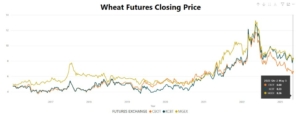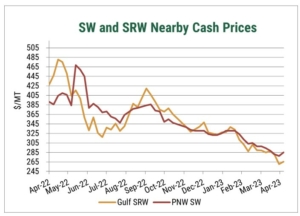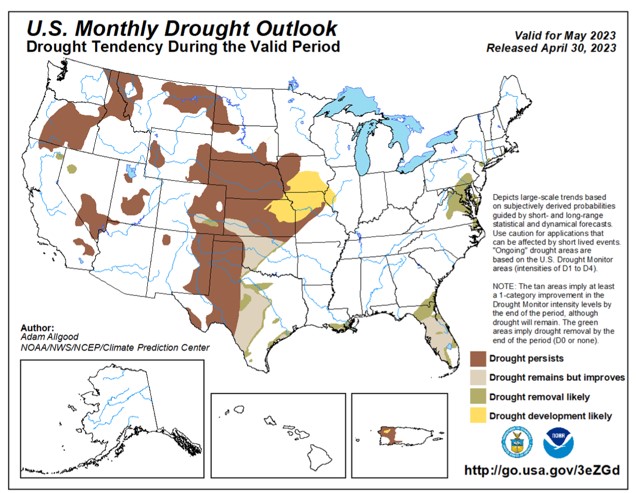Competitive U.S. Soft Wheat Creates Buying Opportunity
Just one year ago, U.S. wheat prices hovered near record highs. The geopolitical ramifications of Russia’s invasion of Ukraine stoked supply concerns and fears of spiraling food price inflation, and India had just banned wheat exports, further fueling wheat supply fears.
Flash forward to the week of May 2, 2023, Chicago Board of Trade soft red winter wheat (SRW) futures traded at their lowest level since March of 2021 at $5.95/bushel, earning that class the elusive honor of being the cheapest wheat on the world market.
After months of high prices, SRW and soft white (SW) classes have finally become more price competitive, providing a buying opportunity for importers. In this article, we will look in-depth at the market conditions for U.S. soft wheat classes and the factors influencing the entire market.

U.S. wheat prices retreated significantly the week of May 5 to touch near two year lows before ending slightly higher, demonstrating how quickly price sentiment can shift, though soft red winter wheat prices have trended lower. Source: U.S. Wheat Associates Price Charting Tool.
Competitive U.S. Soft Wheat Classes
Looking back, the U.S. soft wheat classes were poised to be more competitive thanks to several positive supply-side factors. Last year, both SW and SRW registered above-average production. The SW harvest came in at 4% above the five-year average and 35% above the drought-afflicted 2021/22 crop, while SRW was 16% above the five-year average, even boasting two large crops at 9.8 MMT in 2021/22 and 9.1 MMT in 2022/23.
Moreover, heading into marketing year 2023/24, the production outlook for SRW and SW remains positive. According to the USDA Prospective Plantings Report, SRW planted area increased 18% to 7.8 million acres (3.1 hectares), while white wheat plantings are estimated up 2% at 4.33 million acres (1.75 million hectares). The combination of good production last year and a positive outlook for the 2023 crop helped position SW and SRW to capture demand and remain competitive on the world market.
With the production bump and increased global competition, U.S. soft wheat prices have steadily decreased in the last few weeks. For a brief moment on May 2, U.S. SRW was the cheapest wheat in the world, coming in on average $10.00/MT FOB less than French wheat, $14.00/MT less than Russian wheat, and $13.00/MT less than Ukrainian. As a result, the U.S. Wheat commercial sales recorded 145,000 MT of SRW last week, the entire quantity likely bound for China. Meanwhile, SW wheat FOB prices hovered at $275.00/MT compared to $288.00/MT for Australian Standard White.

U.S. soft wheat prices have trended lower in search of demand. Soft white wheat prices have decreased by 39% since April 2022, while SRW has dropped by 45%. Even since the start of 2023, prices have come down 12% and 18%, respectively. Source: U.S. Wheat Associates Price Report
Underlying Bearish Market Factors
In addition to the positive supply outlook for soft wheat classes, recent bearish market factors have also been at play, influencing all U.S. wheat class prices. Last week hard red spring (HRS hit a nearly two-year low of $7.58/bu while hard red winter wheat (HRW) breached the $8.00/bu barrier to close at $7.71/bu. Seasonal influences also contribute to a fall in prices, especially for the soft wheat classes with a looser balance sheet and optimistic production outlook. Farmers and exporters will need to clear out their bins as new crop approaches to make room for the upcoming harvest.
Additionally, In the last two weeks, rain has fallen on some of the most drought-afflicted areas of the U.S. Southern Plains. Before these showers, it had been over 270 days since 0.25 inches of moisture (6.35 mm) had been recorded in some areas. The rains helped relieve some price pressure as the market assessed the moisture’s impact on drought conditions in the HRW growing region.
Beware The Bull
Demonstrated by this week’s jump in futures prices from the previous week’s lows, bullish influences are always lurking, especially as the Black Sea conflict continues to be an unpredictable bullish influence. As the Black Sea Grain Initiative approaches its May 18 expiration date, the longevity of the corridor hinges on Russia’s continued cooperation.
Furthermore, though the major HRW growing region in the Southern Plains received needed rains, there is concern about its impact. Some say the showers were “too little too late” for the crop as many fields already face abandonment.

Despite the rains in the U.S. Southern Plains, drought persists throughout the central HRW growing region. The recent showers helped improve soil moisture but not enough to reverse the drought impacts. Source: U.S. Department of Agriculture Drought Monitor.
Key Takeaways
This week’s price movements are just the latest example of how quickly market sentiment can shift, especially with influences as unpredictable as the weather and the war in Ukraine. Amidst the persistent market volatility, buyers must be wary of the market trends and be positioned to take advantage of every buying opportunity. As always, U.S. Wheat Associates (USW) representatives are committed to helping customers capitalize on market opportunities and navigate the ever-changing wheat market.


